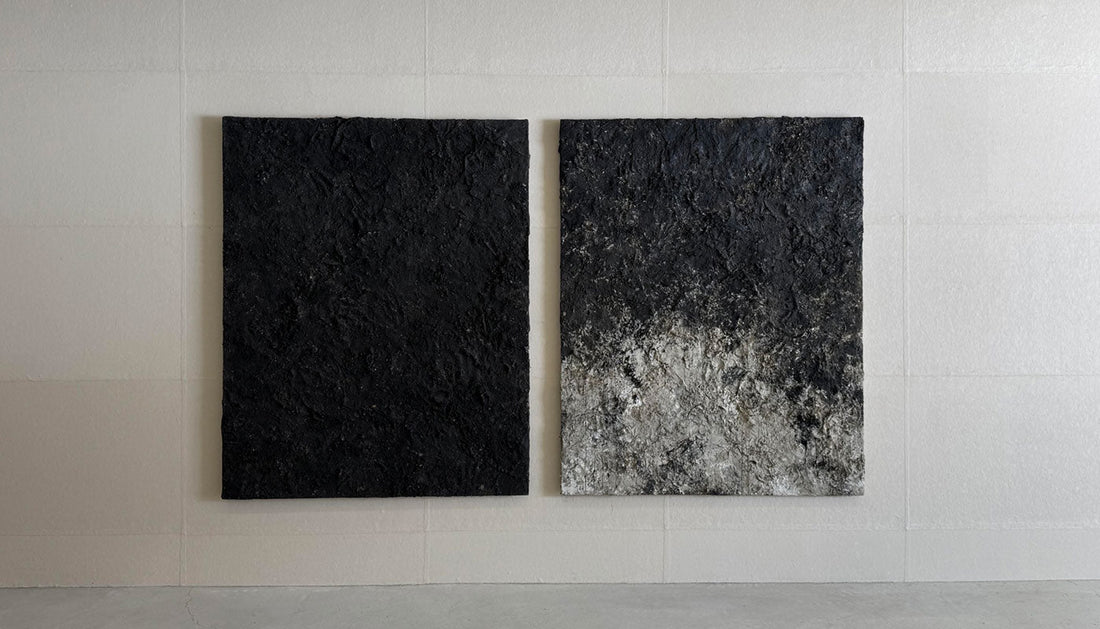
Share
The accumulation of time - Wataru Hatano
APRIL 26 SAT- MAY 25 SUN, 2025
We are pleased to present a solo exhibition by Wataru Hatano, a washi paper artisan and artist based in Ayabe, Kyoto.
Hatano intends to create artworks which act as a tool to offer time and space for–
A space with tranquility
A moment to stand still in silence
A moment to self–reflect
When Hatano thinks about how to capture moments of the past, he remembers the sound of footsteps as you walk across a forest over layers of fallen leaves at the beginning of winter.
As he looks down, he sees a surface of different shapes and colors created through the accumulation of time.
The depths of colour and texture in this series of painting (made with layers of washi, soil and pigment) changes depending on the context of a day, time and place, bringing awareness between the past and future.
In Hatano’s products, traces of accumulation can be seen.
He carefully manages the entire process, from cultivating the Kozo trees that serve as the raw material for washi to the intricate art of papermaking, layering colors onto the washi to create his pieces.
This exhibition will feature not only art pieces and products but also "Ategami," the paper used when adding color to washi, where layers of color have accumulated.
Additionally, we will be offering made-to-order washi tabletop surfaces for sale.
On April 26th, a workshop will be held where participants can make their own tailor made picture frames by applying Hatano’s washi onto the frames. (reservation required)
This is a rare opportunity to experience washi up close.
Now on sale in our online store!


Made-to-Order: Table top made of Japanese paper by Kamisuki Hatano
You can custom order a handmade table-top with a unique texture made of multiple layers of Japanese washi paper pasted together. Please visit the store to order directly and ask our staff for more details.
Produced & shipped from Japan.
Material: Shina plywood
Note: Table legs not included
・Table Top 2400
2400 mm x 1100mm x 30mm
94.49 in × 43.31 in × 1.18 in
・Table Top 2200
2200 mm x 1000mm x 30 mm
86.61 in × 39.37 in × 1.18 in
・Table Top 1800
1800 mm x 900 mm x 30mm
70.87 in × 35.43 in × 1.18 in
・Table Top 1500
1500 mm × 900 mm × 30 mm
59.06 in × 35.43 in × 1.18 in
Washi (Japanese Paper) Picture Frame Workshop
BOOK FROM HERE *Finished

Wataru Hatano
1971 Born in Awaji Island, Hyogo Prefecture, Japan
1995 Graduated from BA Art & Design (specialised in oil painting), Tama Art University (Tokyo, Japan)
1997 Begins to practice Kurotani-Washi in Kurotani, Kyoto Prefecture
2000 Becomes an independent Kurotani-Washi paper craftsman
2007 Registered as one of Kyoto’s certified craftsman by Kyoto Prefecture
2018 Establishes "KAMISUKI HATANO". Moves workshop to his home.
*Washi is made from the bast fibers of plants, and its long fibers interlace, giving it the unique characteristics of being thin, exceptionally durable, and relatively long-lasting. It also cannot be mass-produced.
In contrast, Western paper is made from wood fibers taken from the trunks of trees.


